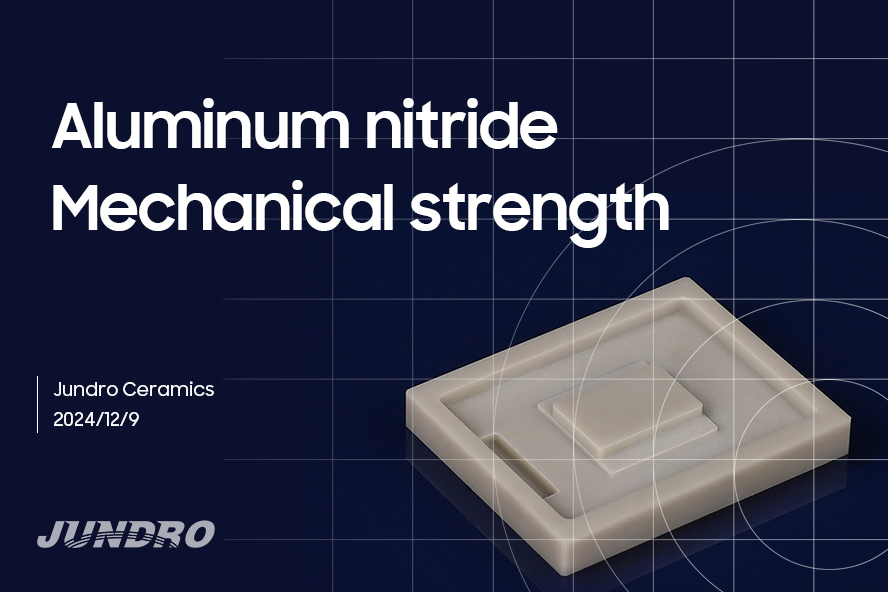Aluminum nitride (AlN) ceramics, as an emerging functional material, play an important role in electronic packaging, heat dissipation substrates, and high-power electronic devices. This is mainly due to its excellent comprehensive performance, among which mechanical strength and thermal shock resistance are the key factors that make it stand out in high-performance applications. This article will explore in detail the advantages and practical applications of aluminum nitride ceramics from two aspects: mechanical properties and thermal shock resistance.

1. Mechanical strength of aluminum nitride ceramics
Aluminum nitride ceramics are known for their high strength and hardness, and are widely used in applications that require high mechanical properties. Its bending strength is usually between 300-400 MPa, which is superior to alumina ceramics, whose bending strength is usually only 250-350 MPa. This high strength comes from the dense crystal structure and strong covalent bonding properties of aluminum nitride ceramics.
The microhardness of aluminum nitride ceramics is about 10-13 GPa, which makes them exhibit excellent resistance to mechanical damage under high stress conditions. In addition, its compressive strength exceeds 2000 MPa, enabling it to withstand significant mechanical loads. Compared to traditional ceramic materials, aluminum nitride ceramics are more adaptable to complex working conditions, especially in applications that require long-term stable performance in high-power electronic devices.
2. Thermal shock resistance
In addition to mechanical strength, aluminum nitride ceramics also exhibit excellent thermal shock resistance. Thermal shock performance refers to the ability of a material to maintain structural integrity and performance stability under sudden temperature changes. During the operation of high-power electronic devices, materials often experience frequent temperature fluctuations, which pose severe requirements for their thermal shock resistance.
The thermal expansion coefficient of aluminum nitride ceramics is about 4.5 × 10 ⁻⁶/° C, which is very close to the thermal expansion coefficient of silicon chips (4.0 × 10 ⁻⁶/° C). This matching significantly reduces the thermal stress caused by inconsistent thermal expansion, thereby reducing the risk of material cracking or detachment.
In addition, the high thermal conductivity of aluminum nitride ceramics (170-230 W/m · K) further enhances their thermal shock resistance. High thermal conductivity can quickly dissipate heat to the surface of the material, avoiding thermal shock failure caused by local high temperatures. Experiments have shown that aluminum nitride ceramics can withstand instantaneous temperature differences of hundreds of degrees Celsius without cracking or damage, which is difficult to achieve in traditional ceramic materials.
3. Microscopic mechanism of aluminum nitride ceramics
The excellent properties of aluminum nitride ceramics are closely related to their microstructure. Its grains are usually densely arranged with few grain boundaries, which is the material basis for high mechanical strength and thermal shock resistance. In addition, the presence of strong covalent bonds (Al-N bonds) in aluminum nitride crystals enables them to effectively resist damage from external stress.
Under thermal shock environment, the thermal conductivity of aluminum nitride ceramics can quickly and uniformly disperse heat, thereby avoiding the phenomenon of local stress concentration. Meanwhile, its low thermal expansion coefficient reduces the accumulation of thermal stress between grain boundaries, which is an important reason why aluminum nitride ceramics can maintain long-term stability.
4. Application Fields
Aluminum nitride ceramics have been widely used in various fields due to their mechanical strength and thermal shock resistance.
Electronic packaging: In high-power electronic modules, aluminum nitride ceramics serve as substrate materials that can withstand large mechanical loads and frequent temperature fluctuations.
• Heat dissipation components: Due to their high thermal conductivity and thermal shock resistance, aluminum nitride ceramics are used as heat sinks or thermal interface materials, especially in power semiconductor devices.
Aerospace: Equipment operating in extreme environments requires materials with high strength and good thermal shock stability, and aluminum nitride ceramics are an ideal choice.
Laser equipment: In high-power lasers, aluminum nitride ceramics can effectively conduct heat and withstand high-speed thermal cycles.
5. Challenges and Future Development Directions
Although aluminum nitride ceramics have significant advantages in performance, their high manufacturing cost and difficult processing still limit their large-scale application. The traditional sintering process requires high temperatures and expensive additives, which directly increases the production cost of materials.
The future development directions include optimizing sintering processes, developing low-cost and high-performance aluminum nitride composite materials, and exploring more efficient processing technologies. In addition, with the increasing demand for high-performance materials in the electronics industry, the balance between performance and cost of aluminum nitride ceramics will gradually shift towards industrial applications.
conclusion
Aluminum nitride ceramics exhibit irreplaceable advantages in high-power electronic devices and other high demand scenarios due to their excellent mechanical strength and thermal shock resistance. Although it still faces certain cost and process challenges, with the advancement of technology and the growth of demand, its application scope and market potential will continue to expand. By further optimizing manufacturing processes and performance, aluminum nitride ceramics will play a more important role in fields such as electronics, energy, and aerospace, providing strong support for the development of high-performance materials in the future.
Dongguan Jundro ceramics Technology Co.,Ltd
E-mail:info@jundro.com
Tel:+86-769-82913501
Fax:+86-769-82913801
Add: Room 306, Gate B, Unit 1, Block 2 South, No. 1 Yile Road, Songshan Lake, Dongguan City, Guangdong Province, China(523808)
© August Dongguan Jundro ceramics Technology Co.,Ltd- 2023